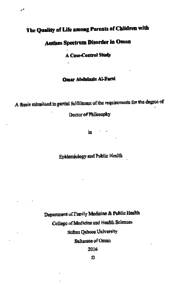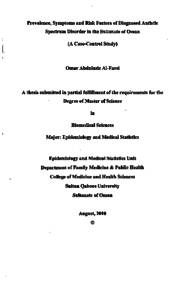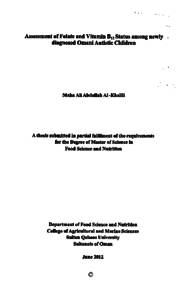Document
Prevalence, symptoms and risk factors of diagnosed autistic spectrum disorder in the Sultanate of Oman : a case-control study
Publisher
Sultan Qaboos University
Gregorian
2010
Language
English
Subject
English abstract
The number of reported autistic children has increased dramatically since the 1970s, especially in Western countries. Similarly, it was observed that there was a gradual increase in the number of children with Autism Spectrum Disorder (ASD) in the behavioral medicine clinic (SQUH). Since there are no previous studies have been done on prevalence of ASD in Oman, we conducted this study to explore the prevalence of ASD in Oman. Moreover, we are interested to identify the symptoms and signs (characteristics) of autistic children. We also aim to measure the degree and extent of association between ASD and the leading risk factors. We used case-control study to achieve our purposes; we selected 260 subjects (130 cases and 130 controls). About 70% of the information was obtained from the parents through telephone interview; the remainder was obtained through face to face interview and self-administered. Chi-square and odds ratio were used to find the association between ASD and various characteristics under study with p-value less than or equal to 0.05 as a significant level of association. Logistic regression and multivariate analysis were used to adjust for confounding variables. Because there has been no treatment for ASD till now but there is an ability to treat the symptoms, we described some characteristics in 130 autistic cases to identify the common symptoms for treatment purpose. We also calculated the prevalence of ASD among children aged 0 -14 years in Oman. The results of crude analysis of the study showed that among demographic risk factors advanced father's age > 49 years (OR=3.81, 95% CI 1.14, 12.68) and mother education (P-value=0.006) were positively associated with the increased risk of ASD. A child's sex was a risk factor of ASD because boys were more likely to get ASD as compared to girls by the ratio 3:1. Among those women who had problems during pregnancy period like psychological stress and social problems were positively associated with the increased risk of ASD (OR= 3.20, 95% CI 1.30, 7.85). Breast feeding was found to be a protective way from ASD and it was positively associated with ASD (OR= 3.50, 95% CI 1.11, 11.04). Among those autistic children who had someone from their relatives affected with the same disorder were positively sorteon associated with ASD (OR=2.90, 95% CI 1.10, 7.67). In addition, Families who have one child with ASD had an increased risk of having another child with the same disorder. After adjustment for possible confounding factors which were nationality of the participants, place of living, mother educational level and monthly family income, approximately the same results were obtained. That means the confounding factors did not have that much impact on our study. After we applied multivariate analysis by using logistic regression (backward step-wise method) for all risk factors under study, we concluded that there were three main risk factors associated with the increased risk of ASD. These factors were advanced father's age, psychological stress and social problems during pregnancy and breast feeding period.
Description
Thesis
Member of
Resource URL
Arabic abstract
عدد الأطفال المسجلين المصابين بالتوحد في ازدياد متسارع منذ السبعينات، خصوصا في البلدان الغربية وبالمثل، فقد لوحظ أن هناك زيادة تدريجية في أعداد الأطفال المصابين بإضطراب طيف التوحد في عيادة الطب السلوكي في مستشفى جامعة السلطان قابوس. وبما أنه لا توجد دراسات سابقة قد تم القيام بها عن انتشار اضطراب طيف التوحد في سلطنة عمان، فقد قمنا بإجراء هذه الدراسة للتعرف على مدى انتشار هذا الإضطراب في السلطنة. وعلاوة على ذلك، نحن مهتمون للتعرف على أعراض وعلامات (خصائص الأطفال المصابين بالتوحد. ونهدف أيضا إلى قياس درجة ومدى ارتباط اضطراب طيف التوحد مع عوامل الخطورة المؤدية لهذا الإضطراب لقد استخدمنا دراسة التحكم المعتمدة لكي نحقق أهداف الدراسة، فقد اخترنا 260 شخص (130 حالة توحد و130 حالة تحكم أي لا يوجد لديهم توحد). تم الحصول على المعلومات عن طريق الوالدين من خلال مقابلة شخصية أو مقابلة هاتفية أو تعبئة المعلومات ذاتيا. لقد قمنا بإستخدام اختبار كايمربع وحساب خطر الإصابة لإيجاد العلاقة بين اضطراب طيف التوحد والخصائص المختلفة تحت الدراسة بأخذ مستوى ثقة أقل من أو يساوي . 05 لتعيين إختبار الفرضية. كما قمنا أيضا بإستخدام الإنحسار اللوجستي المعدل والتحليل المتعدد المتغيرات للحد من تأثير العوامل المؤثرة على العلاقة بين اضطراب طيف التوحد والخصائص المختلفة تحت الدراسة. وبما أنه لا يوجد هناك علاج محدد حتى الآن من اضطراب طيف التوحد ولكن في نفس الوقت توجد هناك قدرة على معالجة أعراض هذا الإضطراب، فقد قمنا بوصف بعض الأعراض لجميع حالات التوحد (130 حالة توحد) لتحديد الأعراض الشائعة وذلك لغرض علاجها. كما قمنا أيضا بحساب معدل انتشار اضطراب طيف التوحد بين الأطفال الذين تتراوح أعمارهم 0-14 عاما في سلطنة عمان.
نتائج التحليل الأحادي للدراسة أظهرت أن من بين الخصائص الديموغرافية: العمر المتقدم للأب في السن (أكثر من 49 سنة) ( 12 . 68 , 1 . 14 OR = 3 . 81 , 95 % CI )ومستوى تعليم الأم لهن علاقة إيجابية مع اضطراب طيف التوحد لدى أبنائهم. كان جنس الطفل عامل خطر لإضطراب طيف التوحد لأن الذكور كانوا أكثر احتمالا للإصابة بإضطراب طيف التوحد مقارنة مع الإناث بنسبة 3 :1 ومن بين النساء اللواتي يعانين من مشاكل خلال فترة الحمل والمشاكل الاجتماعية والضغوط النفسية، كان لها إرتباط بشكل إيجابي مع تزايد خطر إنجاب طفل مصاب بإضطراب طيف التوحد ( 7 . 85 , 1 . 30 OR = 3 . 20 , 95 %
CI. ) وقد تم التعرف على أن الرضاعة الطبيعية وسيلة وقائية من الإصابة بإضطراب طيف التوحد عند الأطفال وكانت مرتبطة بشكل إيجابي مع هذا الإضطراب ( 11 . 04 , 1 . 11 OR = 3 . 50 , 95 % (CI. وإذا كان يوجد هناك من بين هؤلاء الأطفال الذين يعانون من إضطراب طيف التوحد أحدا من أقاربهم يعاني من نفس الإضطراب فإنه توجد علاقة إيجابية مع هذا الإضطراب ( 7 . 67 , 1 . 10 OR = 2 . 90 , 95 % CI. ) وبالإضافة إلى ذلك، الأسر التي يوجد لديها طفل متوحد، توجد هناك احتمالية بإنجاب طفل آخر مصاب بنفس هذا الاضطراب وبعد الحد من تأثير العوامل المحتملة المؤثرة (وهي جنسية الطفل المتوحد، مكان المعيشة، مستوى تعليم الأم، الدخل الشهري للأسرة على العلاقة بين اضطراب طيف التوحد والخصائص المختلفة تحت الدراسة، فقد تم الحصول تقريبا على نفس النتائج وهذا يدل على أن تلك العوامل لم تؤثر على هذه الدراسة. وبعد استخدام التحليل التدرجي اللوجستي التحوفي متعدد المتغيرات لكل أسباب الخطر تحت الدراسة، وجدنا أنه توجد ثلاثة عوامل خطورة مرتبطة بإظطراب طيف التوحد. وهذه العوامل هي تقدم سن الأب في العمر، المشاكل الاجتماعية والضغوط النفسية التي تعاني منها المرأة خلال فترة الحمل، وفترة الرضاعة الطبيعية
نتائج التحليل الأحادي للدراسة أظهرت أن من بين الخصائص الديموغرافية: العمر المتقدم للأب في السن (أكثر من 49 سنة) ( 12 . 68 , 1 . 14 OR = 3 . 81 , 95 % CI )ومستوى تعليم الأم لهن علاقة إيجابية مع اضطراب طيف التوحد لدى أبنائهم. كان جنس الطفل عامل خطر لإضطراب طيف التوحد لأن الذكور كانوا أكثر احتمالا للإصابة بإضطراب طيف التوحد مقارنة مع الإناث بنسبة 3 :1 ومن بين النساء اللواتي يعانين من مشاكل خلال فترة الحمل والمشاكل الاجتماعية والضغوط النفسية، كان لها إرتباط بشكل إيجابي مع تزايد خطر إنجاب طفل مصاب بإضطراب طيف التوحد ( 7 . 85 , 1 . 30 OR = 3 . 20 , 95 %
CI. ) وقد تم التعرف على أن الرضاعة الطبيعية وسيلة وقائية من الإصابة بإضطراب طيف التوحد عند الأطفال وكانت مرتبطة بشكل إيجابي مع هذا الإضطراب ( 11 . 04 , 1 . 11 OR = 3 . 50 , 95 % (CI. وإذا كان يوجد هناك من بين هؤلاء الأطفال الذين يعانون من إضطراب طيف التوحد أحدا من أقاربهم يعاني من نفس الإضطراب فإنه توجد علاقة إيجابية مع هذا الإضطراب ( 7 . 67 , 1 . 10 OR = 2 . 90 , 95 % CI. ) وبالإضافة إلى ذلك، الأسر التي يوجد لديها طفل متوحد، توجد هناك احتمالية بإنجاب طفل آخر مصاب بنفس هذا الاضطراب وبعد الحد من تأثير العوامل المحتملة المؤثرة (وهي جنسية الطفل المتوحد، مكان المعيشة، مستوى تعليم الأم، الدخل الشهري للأسرة على العلاقة بين اضطراب طيف التوحد والخصائص المختلفة تحت الدراسة، فقد تم الحصول تقريبا على نفس النتائج وهذا يدل على أن تلك العوامل لم تؤثر على هذه الدراسة. وبعد استخدام التحليل التدرجي اللوجستي التحوفي متعدد المتغيرات لكل أسباب الخطر تحت الدراسة، وجدنا أنه توجد ثلاثة عوامل خطورة مرتبطة بإظطراب طيف التوحد. وهذه العوامل هي تقدم سن الأب في العمر، المشاكل الاجتماعية والضغوط النفسية التي تعاني منها المرأة خلال فترة الحمل، وفترة الرضاعة الطبيعية
Category
Theses and Dissertations



